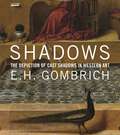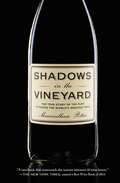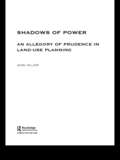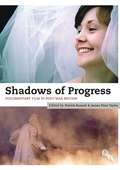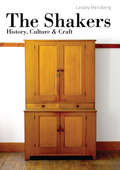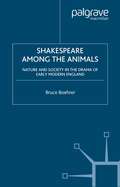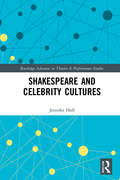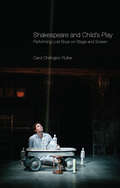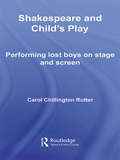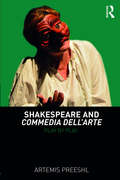- Table View
- List View
Shadows: The Depiction of Cast Shadows in Western Art
by E. H. GombrichIn this intriguing book, E.H. Gombrich, who was one of the world’s foremost art historians, traces how cast shadows have been depicted in Western art through the centuries. Gombrich discusses the way shadows were represented—or ignored—by artists from the Renaissance to the 17th century and then describes how Romantic, Impressionist, and Surrealist artists exploited the device of the cast shadow to enhance the illusion of realism or drama in their representations. First published to accompany an exhibition at the National Gallery, London, in 1995, it is reissued here with additional color illustrations and a new introduction by esteemed scholar Nicholas Penny. It is also now available as an enhanced eBook, with zoomable images and accompanying film footage.
Shadows in the Vineyard: The True Story of the Plot to Poison the World's Greatest Wine
by Maximillian PotterAmazon Best Book of the Month, July 2014Journalist Maximillian Potter uncovers a fascinating plot to destroy the vines of La Romanée-Conti, Burgundy's finest and most expensive wine. In January 2010, Aubert de Villaine, the famed proprietor of the Domaine de la Romanée-Conti, the tiny, storied vineyard that produces the most expensive, exquisite wines in the world, received an anonymous note threatening the destruction of his priceless vines by poison-a crime that in the world of high-end wine is akin to murder-unless he paid a one million euro ransom. Villaine believed it to be a sick joke, but that proved a fatal miscalculation and the crime shocked this fabled region of France. The sinister story that Vanity Fair journalist Maximillian Potter uncovered would lead to a sting operation by some of France's top detectives, the primary suspect's suicide, and a dramatic investigation. This botanical crime threatened to destroy the fiercely traditional culture surrounding the world's greatest wine. SHADOWS IN THE VINEYARD takes us deep into a captivating world full of fascinating characters, small-town French politics, an unforgettable narrative, and a local culture defined by the twinned veins of excess and vitality and the deep reverent attention to the land that runs through it.
Shadows in the Vineyard: The True Story of the Plot to Poison the World's Greatest Wine
by Maximillian PotterJournalist Maximillian Potter uncovers a fascinating plot to destroy the vines of La Romance-Conti, Burgundy's finest and most expensive wine.In January 2010, Aubert de Villaine, the famed proprietor of the Domaine de la Romance-Conti, the tiny, storied vineyard that produces the most expensive, exquisite wines in the world, received an anonymous note threatening the destruction of his priceless vines by poison—a crime that in the world of high-end wine is akin to murder—unless he paid a one million euro ransom. Villaine believed it to be a sick joke, but that proved a fatal miscalculation and the crime shocked this fabled region of France. The sinister story that Vanity Fair journalist Maximillian Potter uncovered would lead to a sting operation by some of France's top detectives, the primary suspect's suicide, and a dramatic investigation. This botanical crime threatened to destroy the fiercely traditional culture surrounding the world's greatest wine.Shadows in the Vineyard takes us deep into a captivating world full of fascinating characters, small-town French politics, an unforgettable narrative, and a local culture defined by the twinned veins of excess and vitality and the deep reverent attention to the land that runs through it.
Shadows of Power: An Allegory of Prudence in Land-Use Planning (RTPI Library Series)
by Jean HillierShadows of Power examines public policy and in particular, the communicative processes of policy and decision-making. It explore the important who, how and why issues of policy decisions. Who really takes the decisions? How are they arrived at and why were such processes used? What relations of power may be revealed between the various participants?Using stories from planning practices, this book shows that local planning decisions, particularly those which involve consideration of issues of 'public space' cannot be understood separately from the socially constructed, subjective territorial identities, meanings and values of the local people and the planners concerned. Nor can it be fully represented as a linear planning process concentrating on traditional planning policy-making and decision-making ideas of survey analysis-plan or officer recommendation-council decision-implementation. Such notions assume that policy-and decision-making proceed in a relatively technocratic and value neutral, unidirectional, step-wise process towards a finite end point. In this book Jean Hiller explores ways in which different values and mind-sets may affect planning outcomes and relate to systemic power structures. By unpacking these and bring them together as influences on participants' communication, she reveals influences at work in decision-making processes that were previously invisible.If planning theory is to be of real use to practitioners, it needs to address practice as it is actually encountered in the worlds of planning officers and elected representatives. Hillier shed light on the shadows so that practitioners may be better able to understand the circumstances in which they find themselves and act more effectively in what is in reality a messy, highly politicised decision-making process.
Shadows of Power: An Allegory of Prudence in Land-Use Planning (RTPI Library Series)
by Jean HillierShadows of Power examines public policy and in particular, the communicative processes of policy and decision-making. It explore the important who, how and why issues of policy decisions. Who really takes the decisions? How are they arrived at and why were such processes used? What relations of power may be revealed between the various participants?Using stories from planning practices, this book shows that local planning decisions, particularly those which involve consideration of issues of 'public space' cannot be understood separately from the socially constructed, subjective territorial identities, meanings and values of the local people and the planners concerned. Nor can it be fully represented as a linear planning process concentrating on traditional planning policy-making and decision-making ideas of survey analysis-plan or officer recommendation-council decision-implementation. Such notions assume that policy-and decision-making proceed in a relatively technocratic and value neutral, unidirectional, step-wise process towards a finite end point. In this book Jean Hiller explores ways in which different values and mind-sets may affect planning outcomes and relate to systemic power structures. By unpacking these and bring them together as influences on participants' communication, she reveals influences at work in decision-making processes that were previously invisible.If planning theory is to be of real use to practitioners, it needs to address practice as it is actually encountered in the worlds of planning officers and elected representatives. Hillier shed light on the shadows so that practitioners may be better able to understand the circumstances in which they find themselves and act more effectively in what is in reality a messy, highly politicised decision-making process.
Shadows of Progress: Documentary Film in Post-War Britain
by Patrick Russell & James Piers TaylorBritain emerged from war a changed country, facing new social, industrial and cultural challenges. Its documentary film tradition – established in the 1930s and 1940s around legendary figures such as Grierson, Rotha and Jennings – continued evolving, utilising technical advances, displaying robust aesthetic concerns, and benefiting from the entry into the industry of wealthy commercial sponsors. Thousands of films were seen by millions worldwide. Received wisdom has been that British documentary went into swift decline after the war, resurrected only by Free Cinema and the arrival of television documentary. Shadows of Progress demolishes these simplistic assumptions, presenting instead a complex and nuanced picture of the sponsored documentary in flux. Patrick Russell and James Piers Taylor explore the reasons for the period's critical neglect, and address the sponsorship, production, distribution and key themes of British documentary. They paint a vivid picture of institutions – from public bodies to multinational industries – constantly redefining their relationships with film as a form of enlightened public relations. Many of the issues that these films addressed could not be more topical today: the rise of environmentalism; the balance of state and industry, individual and community; a nation and a world travelling from bust to boom and back again. In the second part of the book, contributors from the curatorial and academic world provide career biographies of key film-makers of the period. From Lindsay Anderson's lesser-known early career to neglected film-makers like John Krish, Sarah Erulkar, Eric Marquis and Derrick Knight, a kaleidoscopic picture is built up of the myriad relationships of artist and sponsor.
Shadows of Progress: Documentary Film in Post-War Britain
Britain emerged from war a changed country, facing new social, industrial and cultural challenges. Its documentary film tradition – established in the 1930s and 1940s around legendary figures such as Grierson, Rotha and Jennings – continued evolving, utilising technical advances, displaying robust aesthetic concerns, and benefiting from the entry into the industry of wealthy commercial sponsors. Thousands of films were seen by millions worldwide. Received wisdom has been that British documentary went into swift decline after the war, resurrected only by Free Cinema and the arrival of television documentary. Shadows of Progress demolishes these simplistic assumptions, presenting instead a complex and nuanced picture of the sponsored documentary in flux. Patrick Russell and James Piers Taylor explore the reasons for the period's critical neglect, and address the sponsorship, production, distribution and key themes of British documentary. They paint a vivid picture of institutions – from public bodies to multinational industries – constantly redefining their relationships with film as a form of enlightened public relations. Many of the issues that these films addressed could not be more topical today: the rise of environmentalism; the balance of state and industry, individual and community; a nation and a world travelling from bust to boom and back again. In the second part of the book, contributors from the curatorial and academic world provide career biographies of key film-makers of the period. From Lindsay Anderson's lesser-known early career to neglected film-makers like John Krish, Sarah Erulkar, Eric Marquis and Derrick Knight, a kaleidoscopic picture is built up of the myriad relationships of artist and sponsor.
Shadows of Reality: The Fourth Dimension in Relativity, Cubism, and Modern Thought
by Mr. Tony RobbinIn this insightful book, which is a revisionist math history as well as a revisionist art history, Tony Robbin, well known for his innovative computer visualizations of hyperspace, investigates different models of the fourth dimension and how these are applied in art and physics. Robbin explores the distinction between the slicing, or Flatland, model and the projection, or shadow, model. He compares the history of these two models and their uses and misuses in popular discussions. Robbin breaks new ground with his original argument that Picasso used the projection model to invent cubism, and that Minkowski had four-dimensional projective geometry in mind when he structured special relativity. The discussion is brought to the present with an exposition of the projection model in the most creative ideas about space in contemporary mathematics such as twisters, quasicrystals, and quantum topology. Robbin clarifies these esoteric concepts with understandable drawings and diagrams.Robbin proposes that the powerful role of projective geometry in the development of current mathematical ideas has been long overlooked and that our attachment to the slicing model is essentially a conceptual block that hinders progress in understanding contemporary models of spacetime. He offers a fascinating review of how projective ideas are the source of some of today’s most exciting developments in art, math, physics, and computer visualization.
Shadows of the Prophet: Martial Arts and Sufi Mysticism (Muslims in Global Societies Series #2)
by Douglas S. FarrerShaken, Not Stirred!: James Bond in the Spotlight of Physics (Science and Fiction)
by Metin Tolan Joachim StolzeHow do James Bond’s X-ray glasses work, the ones he uses to see whether the lady at the roulette table has a pistol concealed in her underwear? Is it really possible to launch oneself into the air and catch up with a plane that is free-falling towards the earth? Or to shoot down a helicopter with a pistol? In this lively and informative book, Germany's boldest physics professor Metin Tolan analyses the stunts and gadgets of the 007 films and even answers the question of all questions: Why does Bond drink his vodka martini shaken, not stirred? "So much entertaining science is a rare thing." Spiegel Online
The Shakers: History, Culture and Craft (Shire Library Usa Ser.)
by Lesley HerzbergShaker handicrafts' dignified simplicity is perhaps our greatest example of form following function. An off-shoot of Quakerism, the Shakers sought to create a heaven on earth through both worship and diligent work. Practical yet attractive, the furniture, textiles, tools and machinery of the Shakers are utterly distinctive and became famous the world over during the twentieth century, with certain Modernist architects and designers finding unexpected common ground with this decidedly non-modern sect. 'Shaker Handicraft' – the first Shaker exhibition at the Whitney Museum of American Art in 1935 – was only the first of many exhibits, and today the spirit of the Shakers – and the clean lines, solid construction and honest functionality of their crafts – make it one of the most popular and timeless design categories in the US and beyond.
Shakespeare: The instant Sunday Times Bestseller from our most beloved stage and screen actress (Shakespeare On Stage Ser. #7)
by Judi DenchA LOVE LETTER TO 67 YEARS OF ACTING ON STAGEA witty, insightful journey through the plays and tales of our beloved Shakespeare‘Wonderfully inspiring. A delightful spell in the company of one of our greatest actresses’ Daily Mail, Books of the Year‘Gloriously entertaining. Reading it feels like a chat with an old friend’ Observer‘A magical love letter to Shakespeare’ Kenneth Branagh----For the very first time, Judi Dench opens up about every Shakespearean role she has played in her seven-decade career, from Lady Macbeth and Titania to Ophelia and Cleopatra.Here, she reveals her behind the scenes secrets; inviting us to share in her triumphs, disasters, and backstage shenanigans, all brightened by her mischievous sense of humour and striking honesty.This is Judi's love letter to William Shakespeare – the man who pays the rent.----Praise for The Man Who Pays the Rent'This book is pure enchantment’ Daily Mail'This is a gloriously entertaining tour through the canon in the company of perhaps the most experienced living Shakespearean actor' Observer'An utterly delightful book. An unstoppable stream of anecdotes, recollections and asides' Telegraph‘Companionable and compelling, mischievous and convivial – it genuinely feels like you’re sitting at her kitchen table with Judi Dench’ Guardian‘Gorgeous’ Literary Review‘A wonderful mixture of appreciation and anecdote’ Financial Times, Books of the YearInstant Sunday Times bestseller, November 2023
Shakespeare Among the Animals: Nature and Society in the Drama of Early Modern England (Early Modern Cultural Studies 1500–1700)
by B. BoehrerShakespeare Among the Animals examines the role of animal-metaphor in the Shakespeare stage, particularly as such metaphor serves to underwrite various forms of social difference. Working through texts such as Shakespeare's Midsummer Night's Dream , Jonson's Volpone , and Middleton's A Chaste Maid in Cheapside , different chapters of the study focus upon the allegedly natural character of femininity, masculinity, and ethnicity, while a fourth chapter considers the nature of the natural world itself as it appears on the Renaissance stage. Addressing each of these topics in turn, Shakespeare Among the Animals explores the notions of cultural order that underlie early modern conceptions of the natural world, and the ideas of nature implicit in early modern social practice.
Shakespeare and: The Merry Wives of Windsor (ISSN)
by Elizabeth SchaferSeismic shifts in the theatrical meanings of The Merry Wives of Windsor have taken place across the centuries as Shakespeare’s frequently performed play has relocated to Windsor across the world, journeying along the production/adaptation/appropriation continuum.This (eco-)performance history of Shakespeare’s The Merry Wives of Windsor not only offers the first in-depth analysis of the play in production, with a particular focus on the representation of merry women, but also utilises the comedy’s forest-aware dramaturgy to explore Mistress Page’s concept of being ‘frugal in my mirth’ in relation to sustainable theatre practices. Herne’s Oak – the fictitious tree in Windsor Forest where everyone meets in the final scene of the play – is utilised to enable a maverick but ecologically based reframing of the productions of Merry Wives analysed here.This study engages with gender, physical comedy, and cultural relocations of Windsor across the world to offer new insight into Merry Wives and its theatricality.
Shakespeare and: The Merry Wives of Windsor (ISSN)
by Elizabeth SchaferSeismic shifts in the theatrical meanings of The Merry Wives of Windsor have taken place across the centuries as Shakespeare’s frequently performed play has relocated to Windsor across the world, journeying along the production/adaptation/appropriation continuum.This (eco-)performance history of Shakespeare’s The Merry Wives of Windsor not only offers the first in-depth analysis of the play in production, with a particular focus on the representation of merry women, but also utilises the comedy’s forest-aware dramaturgy to explore Mistress Page’s concept of being ‘frugal in my mirth’ in relation to sustainable theatre practices. Herne’s Oak – the fictitious tree in Windsor Forest where everyone meets in the final scene of the play – is utilised to enable a maverick but ecologically based reframing of the productions of Merry Wives analysed here.This study engages with gender, physical comedy, and cultural relocations of Windsor across the world to offer new insight into Merry Wives and its theatricality.
Shakespeare and Celebrity Cultures (Routledge Advances in Theatre & Performance Studies)
by Jennifer HollThis book argues that Shakespeare and various cultures of celebrity have enjoyed a ceaselessly adaptive, symbiotic relationship since the final decade of the sixteenth century, through which each entity has contributed to the vitality and adaptability of the other. In five chapters, Jennifer Holl explores the early modern culture of theatrical celebrity and its resonances in print and performance, especially in Shakespeare’s interrogations of this emerging phenomenon in sonnets and histories, before moving on to examine the ways that shifting cultures of stage, film, and digital celebrity have perpetually recreated the Shakespeare, or even the #shakespeare, with whom audiences continue to interact. Situated at an intersection of multiple critical conversations, this book will be of great interest to scholars and graduate students of Shakespeare and Shakespearean appropriations, early modern theater, and celebrity studies.
Shakespeare and Celebrity Cultures (Routledge Advances in Theatre & Performance Studies)
by Jennifer HollThis book argues that Shakespeare and various cultures of celebrity have enjoyed a ceaselessly adaptive, symbiotic relationship since the final decade of the sixteenth century, through which each entity has contributed to the vitality and adaptability of the other. In five chapters, Jennifer Holl explores the early modern culture of theatrical celebrity and its resonances in print and performance, especially in Shakespeare’s interrogations of this emerging phenomenon in sonnets and histories, before moving on to examine the ways that shifting cultures of stage, film, and digital celebrity have perpetually recreated the Shakespeare, or even the #shakespeare, with whom audiences continue to interact. Situated at an intersection of multiple critical conversations, this book will be of great interest to scholars and graduate students of Shakespeare and Shakespearean appropriations, early modern theater, and celebrity studies.
Shakespeare and Child's Play: Performing Lost Boys on Stage and Screen
by Carol Chillington RutterShakespeare wrote more than fifty parts for children, amounting to the first comprehensive portrait of childhood in the English theatre. Focusing mostly on boys, he put sons against fathers, servants against masters, innocence against experience, testing the notion of masculinity, manners, morals, and the limits of patriarchal power. He explored the nature of relationships and ideas about parenting in terms of nature and nurture, permissiveness and discipline, innocence and evil. He wrote about education, adolescent rebellion, delinquency, fostering, and child-killing, as well as the idea of the redemptive child who ‘cures’ diseased adult imaginations. ‘Childness’ – the essential nature of being a child – remains a vital critical issue for us today. In Shakespeare and Child’s-Play Carol Rutter shows how recent performances on stage and film have used the range of Shakespeare’s insights in order to re-examine and re-think these issues in terms of today’s society and culture.
Shakespeare and Child's Play: Performing Lost Boys on Stage and Screen
by Carol Chillington RutterShakespeare wrote more than fifty parts for children, amounting to the first comprehensive portrait of childhood in the English theatre. Focusing mostly on boys, he put sons against fathers, servants against masters, innocence against experience, testing the notion of masculinity, manners, morals, and the limits of patriarchal power. He explored the nature of relationships and ideas about parenting in terms of nature and nurture, permissiveness and discipline, innocence and evil. He wrote about education, adolescent rebellion, delinquency, fostering, and child-killing, as well as the idea of the redemptive child who ‘cures’ diseased adult imaginations. ‘Childness’ – the essential nature of being a child – remains a vital critical issue for us today. In Shakespeare and Child’s-Play Carol Rutter shows how recent performances on stage and film have used the range of Shakespeare’s insights in order to re-examine and re-think these issues in terms of today’s society and culture.
Shakespeare and Classic Works in the Classroom: Teaching Pre-20th Century Literature at KS2 and KS3
by Dennis CarterWith supportive guidelines for Key Stages 2 and 3 this book offers active approaches for teaching pre-twentieth century literature with confidence. Key texts including The Odyssey, Hamlet and The Rime of the Ancient Mariner are explained in a very practical and accessible way. This text allows for creativity amongst pupils at the same time as improving their reading and writing abilities within the literacy strategy objectives and KS3 English framework guidelines. The author looks to develop an active pedagogy that encompasses the literacy strategy, the KS3 English framework and the creative arts. Using case studies from primary and secondary school projects a series of lessons are proposed for each year group from Year 4 though to Year 8. The lessons cover poetry, drama, story and the novel.
Shakespeare and Classic Works in the Classroom: Teaching Pre-20th Century Literature at KS2 and KS3
by Dennis CarterWith supportive guidelines for Key Stages 2 and 3 this book offers active approaches for teaching pre-twentieth century literature with confidence. Key texts including The Odyssey, Hamlet and The Rime of the Ancient Mariner are explained in a very practical and accessible way. This text allows for creativity amongst pupils at the same time as improving their reading and writing abilities within the literacy strategy objectives and KS3 English framework guidelines. The author looks to develop an active pedagogy that encompasses the literacy strategy, the KS3 English framework and the creative arts. Using case studies from primary and secondary school projects a series of lessons are proposed for each year group from Year 4 though to Year 8. The lessons cover poetry, drama, story and the novel.
Shakespeare and Comics: Negotiating Cultural Value (Shakespeare and Adaptation)
by Professor Mark Thornton BurnettFrom their inception, 'low culture' comics have intersected with the 'high culture' of Shakespeare. This is the first book-length collection dedicated entirely to the exploration of this collision. Its chapters illuminate the ways in which different texts, time periods, politics, authors, media, approaches and forms interact. Ranging from Classic Comics to Marvel, from tebeo to manga, from independent to mainstream comics, texts explored include Y: The Last Man, Neil Gaiman and Charles Vess's 'A Midsummer Night's Dream' (The Sandman #19), The League of Extraordinary Gentlemen, I Am Alfonso Jones, Marvel 1602, Doom 2099, and manga adaptations of The Tempest and Macbeth, among many others.As comic books and their big-screen progeny dominate mainstream popular culture, the association of Shakespeare with comics offers creators and critics tools with which to interrogate the place of Shakespeare within the English and global literary and cultural traditions. Shakespeare and Comics argues that, at a moment when the reassessment and reimagining of literary canons has become more urgent than ever, thinking about Shakespeare through the lens of comics invites us to imagine a literary and cultural landscape in which so-called 'great works' exist alongside and in equal conversation with marginalized writers, topics and forms.
Shakespeare and Comics: Negotiating Cultural Value (Shakespeare and Adaptation)
by Professor Mark Thornton BurnettFrom their inception, 'low culture' comics have intersected with the 'high culture' of Shakespeare. This is the first book-length collection dedicated entirely to the exploration of this collision. Its chapters illuminate the ways in which different texts, time periods, politics, authors, media, approaches and forms interact. Ranging from Classic Comics to Marvel, from tebeo to manga, from independent to mainstream comics, texts explored include Y: The Last Man, Neil Gaiman and Charles Vess's 'A Midsummer Night's Dream' (The Sandman #19), The League of Extraordinary Gentlemen, I Am Alfonso Jones, Marvel 1602, Doom 2099, and manga adaptations of The Tempest and Macbeth, among many others.As comic books and their big-screen progeny dominate mainstream popular culture, the association of Shakespeare with comics offers creators and critics tools with which to interrogate the place of Shakespeare within the English and global literary and cultural traditions. Shakespeare and Comics argues that, at a moment when the reassessment and reimagining of literary canons has become more urgent than ever, thinking about Shakespeare through the lens of comics invites us to imagine a literary and cultural landscape in which so-called 'great works' exist alongside and in equal conversation with marginalized writers, topics and forms.
Shakespeare and Commedia dell'Arte: Play by Play
by Artemis PreeshlShakespeare and Commedia dell’Arte examines the ongoing influence of commedia dell’arte on Shakespeare’s plays. Exploring the influence of commedia dell’arte improvisation, sight gags, and wordplay on the development of Shakespeare’s plays, Artemis Preeshl blends historical research with extensive practical experience to demonstrate how these techniques might be applied when producing some of Shakespeare's best-known works today. Each chapter focuses on a specific play, from A Midsummer Night’s Dream to The Winter’s Tale, drawing out elements of commedia dell’arte style in the playscripts and in contemporary performance. Including contemporary directors’ notes and interviews with actors and audience members alongside Elizabethan reviews, criticism, and commentary, Shakespeare and Commedia dell’Arte presents an invaluable resource for scholars and students of Renaissance theatre.
Shakespeare and Commedia dell'Arte: Play by Play
by Artemis PreeshlShakespeare and Commedia dell’Arte examines the ongoing influence of commedia dell’arte on Shakespeare’s plays. Exploring the influence of commedia dell’arte improvisation, sight gags, and wordplay on the development of Shakespeare’s plays, Artemis Preeshl blends historical research with extensive practical experience to demonstrate how these techniques might be applied when producing some of Shakespeare's best-known works today. Each chapter focuses on a specific play, from A Midsummer Night’s Dream to The Winter’s Tale, drawing out elements of commedia dell’arte style in the playscripts and in contemporary performance. Including contemporary directors’ notes and interviews with actors and audience members alongside Elizabethan reviews, criticism, and commentary, Shakespeare and Commedia dell’Arte presents an invaluable resource for scholars and students of Renaissance theatre.
